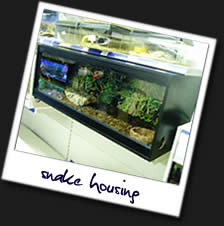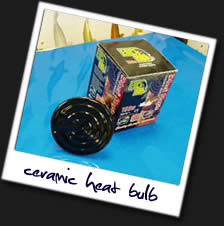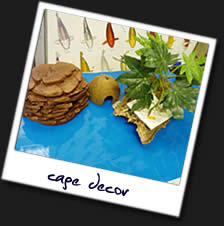www.reptiles-info.co.uk
Snake Housing:
In order to provide the perfect housing for your corn snake we at reptiles-info have provided a guide to all of the necessary factors that need to be taken into consideration when finding the correct cage for your snake.
Cage Setup:

Your snake's cage set up should be prepared around aweek before you put the snake into its new housing this helps you to discover if any items within the cage are not working properly and it will allow you to solely concentrate on the welfare of the snake in its new surroundings. There are many ways to house your snake from a wooden cage with lockable glass doors, a converted aquarium or a molded plastic vivarium all of which must be secure so that the snake cannot escape from its housing. A plastic molded vivarium is a perfect option fin a beginner as they are much cheaper than installing a large display cage. In order to make a successful environment for your corn snake the factors that need to be covered are the cage size, heating, lighting, ventilation, decor and cleanliness and hygiene of your corn snakes cage all of which are covered in detail below.
Cage Size:
The size of a corn snakes' cage need only be large enough to house a snake comfortably for example a simple shoe box would be acceptable for a hatchling and a corn snake of around 14-24 inch/36-61cm can be housed correctly in a ten gallon aquarium. However this would not be suitable for an adult where a 15-20 gallon aquarium would be needed, in order to get the best possible sized tank for your snake you can also follow the rule of thumb that the cage's minimum length should be two thirds of the snakes length and the tanks' width should be half the snakes length.
Heating:

In order to provide the correct temperature for your corn snake it is advised that you use a heat mat underneath your snake's housing that equates to around half the length of your cage this should enable the correct background heating for your snakes housing giving the cage a cool and warm area. It is important that you maintain a constant temperature of no lower than 20°C in the coolest area of the tank with the hottest area of the cage being no warmer than 32°C. The reason for having a warm and cool area within a snakes housing is due to snakes being ectothermic and they can only regulate the body temperature according to the climate of their environment. To further recreate an area of high temperature within the snakes housing a ceramic heater or basking lamp can be installed to create a 'hot spot', this should be monitored closely with a thermostat and used in conjunction with a day/night cycle of fourteen hours of light in the summer and eight hours in the winter. Try to avoid using hot rocks within your housing as they are prone to malfunction and could cause injury and burn your snake. For More Information On Reptile Heating Click Here
Lighting:
When you are lighting your snakes housing it is wise to take into account that snakes do not seem to need artificial lights when kept as pets and lamps are often used as an optional extra in order to improve the visual look of the cage. Although corn snakes do not need a UV light source they can thrive on a cage being illuminated with the room lights alone. However a spotlight or basking light does provide an excellent way to regulate the heat within your snakes housing and often when snakes are exposed to UV light they will bask in it for hours. For More Information On Reptile Lighting Click Here
Ventilation:
The ventilation of a corn snakes housing can be the success or failure of how well you keep your snake. The reasons for ventilation being a key factor are that snakes will become agitated with stagnant, damp and airless conditions within tsiir housing. A way that you can keep fresh air moving is to utilize the draughts caused by heated air rising to flush out the cage and drag fresh air in. Humidity can also affect ventilation and the health of the snake too much humidity can cause respiratory infections and too little humidity can cause dehydration, a medium sized water dish placed in the housing should provide the correct humidity for the snake.
Cage Decor:

The substrate of your snakes housing can range from avariety of things. An easy way to clean and maintain the floor of your housing would be to use newspaper, rolled corrugate, aspen shavings, cypress bark mulch and dry leaves as this can be taken in and out of the housing easily. Another form of substrate would be to use sand this will be more visually appealing and allow the snake to burrow into the sand. The decor of the cage can also be improved by using a climbing branch and repti-vines that will add refuges for the snake to shed its skin and to hide in all of which must be fitted securely to prevent injury to the snake. A hiding box can also be created in order to provide a safe area for a snake to be out of sight, this can be done by using cork bark or curio wood in different shapes to provide a visual barrier for the snake. A water dish should always be present in a snakes housing in the cool end of the terrarium so that the snake can drink from the dish freely when it needs to. A larger bathing dish can also be placed into the snake's enclosure in order to aid in the shedding of the snakes skin as this will allow the corn snake to soak in the dish.
Cage Cleanliness:
It is best to maintain your corn snakes housing by regularly scheduling a routine clean once or twice a week. This would involve cleaning all non-porous surfaces with vetaclene and I advise that any item that can't be easily cleaned should be removed from the tank completely.
Snake Pages






